Nursing Assignment: Applying Simon Roach's 6 C's to Nursing Practice
VerifiedAdded on 2023/01/18
|5
|1234
|69
Essay
AI Summary
This nursing assignment delves into Sister Simon Roach's 6 C's of nursing care, which include commitment, comportment, compassion, competence, conscience, and confidence. The essay focuses on three key aspects: confidence, compassion, and competence, and how they align with the NMBA code of conduct. Confidence is highlighted as crucial for handling difficult situations and adhering to NMBA codes 2.1 and 3.4. Compassion is discussed as vital for connecting with patients and creating a supportive environment, relating to NMBA codes 3.2 and 3.3. Competence is presented as essential for adhering to guidelines and providing effective care, aligning with NMBA codes 3.2 and 2.2. The assignment concludes that by adhering to the 6 C's, nurses can overcome limitations and provide effective, culturally safe care.
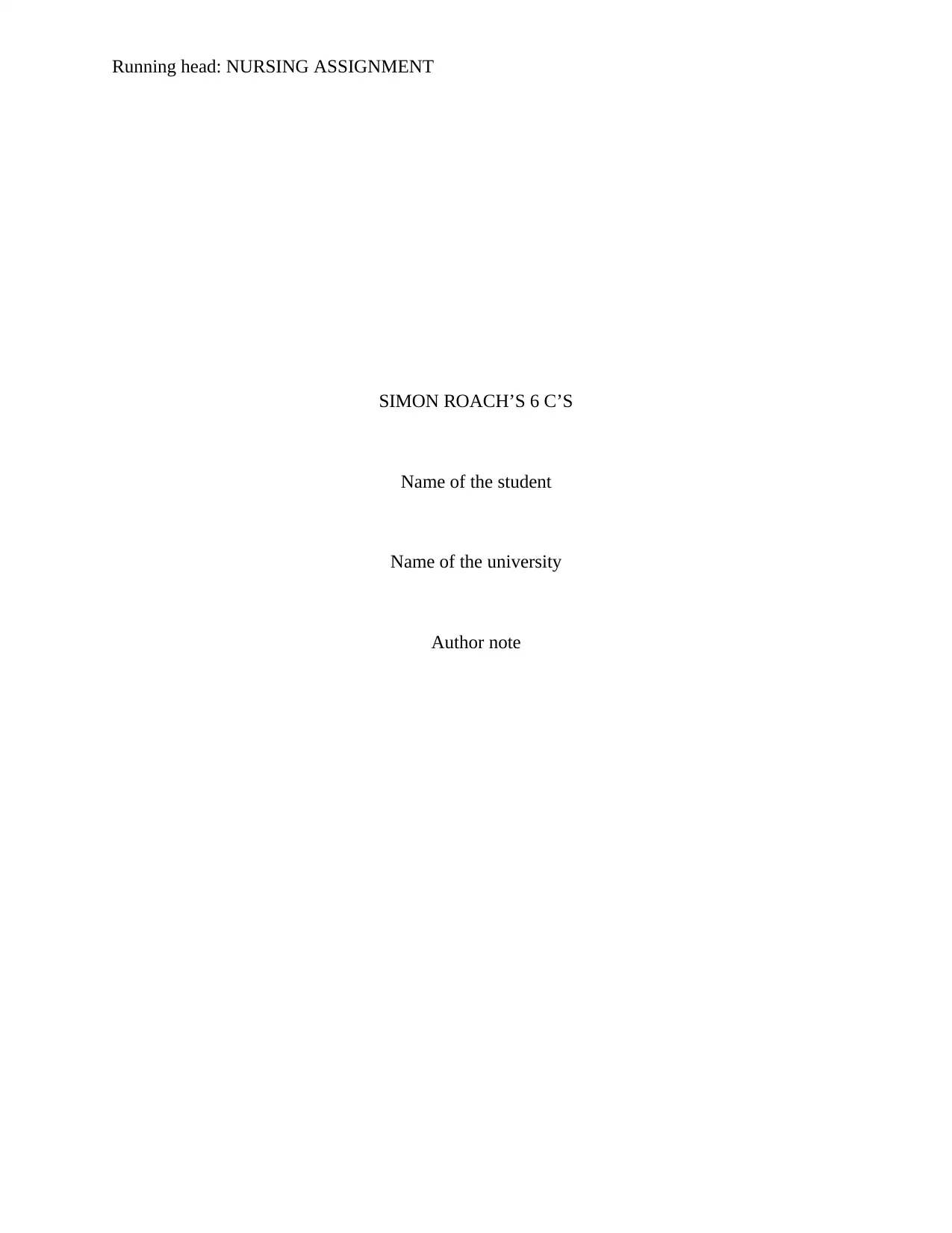
Running head: NURSING ASSIGNMENT
SIMON ROACH’S 6 C’S
Name of the student
Name of the university
Author note
SIMON ROACH’S 6 C’S
Name of the student
Name of the university
Author note
Paraphrase This Document
Need a fresh take? Get an instant paraphrase of this document with our AI Paraphraser
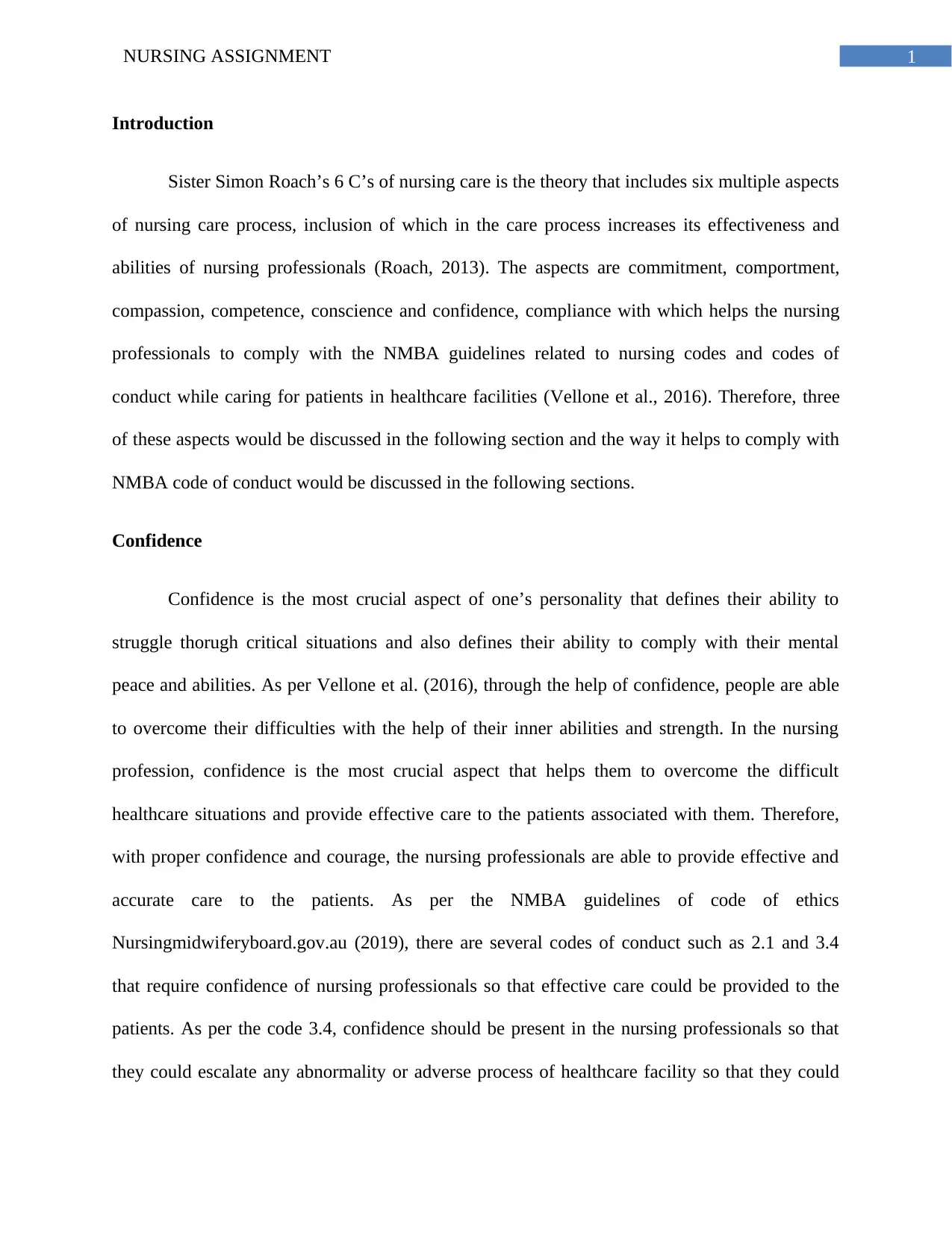
1NURSING ASSIGNMENT
Introduction
Sister Simon Roach’s 6 C’s of nursing care is the theory that includes six multiple aspects
of nursing care process, inclusion of which in the care process increases its effectiveness and
abilities of nursing professionals (Roach, 2013). The aspects are commitment, comportment,
compassion, competence, conscience and confidence, compliance with which helps the nursing
professionals to comply with the NMBA guidelines related to nursing codes and codes of
conduct while caring for patients in healthcare facilities (Vellone et al., 2016). Therefore, three
of these aspects would be discussed in the following section and the way it helps to comply with
NMBA code of conduct would be discussed in the following sections.
Confidence
Confidence is the most crucial aspect of one’s personality that defines their ability to
struggle thorugh critical situations and also defines their ability to comply with their mental
peace and abilities. As per Vellone et al. (2016), through the help of confidence, people are able
to overcome their difficulties with the help of their inner abilities and strength. In the nursing
profession, confidence is the most crucial aspect that helps them to overcome the difficult
healthcare situations and provide effective care to the patients associated with them. Therefore,
with proper confidence and courage, the nursing professionals are able to provide effective and
accurate care to the patients. As per the NMBA guidelines of code of ethics
Nursingmidwiferyboard.gov.au (2019), there are several codes of conduct such as 2.1 and 3.4
that require confidence of nursing professionals so that effective care could be provided to the
patients. As per the code 3.4, confidence should be present in the nursing professionals so that
they could escalate any abnormality or adverse process of healthcare facility so that they could
Introduction
Sister Simon Roach’s 6 C’s of nursing care is the theory that includes six multiple aspects
of nursing care process, inclusion of which in the care process increases its effectiveness and
abilities of nursing professionals (Roach, 2013). The aspects are commitment, comportment,
compassion, competence, conscience and confidence, compliance with which helps the nursing
professionals to comply with the NMBA guidelines related to nursing codes and codes of
conduct while caring for patients in healthcare facilities (Vellone et al., 2016). Therefore, three
of these aspects would be discussed in the following section and the way it helps to comply with
NMBA code of conduct would be discussed in the following sections.
Confidence
Confidence is the most crucial aspect of one’s personality that defines their ability to
struggle thorugh critical situations and also defines their ability to comply with their mental
peace and abilities. As per Vellone et al. (2016), through the help of confidence, people are able
to overcome their difficulties with the help of their inner abilities and strength. In the nursing
profession, confidence is the most crucial aspect that helps them to overcome the difficult
healthcare situations and provide effective care to the patients associated with them. Therefore,
with proper confidence and courage, the nursing professionals are able to provide effective and
accurate care to the patients. As per the NMBA guidelines of code of ethics
Nursingmidwiferyboard.gov.au (2019), there are several codes of conduct such as 2.1 and 3.4
that require confidence of nursing professionals so that effective care could be provided to the
patients. As per the code 3.4, confidence should be present in the nursing professionals so that
they could escalate any abnormality or adverse process of healthcare facility so that they could
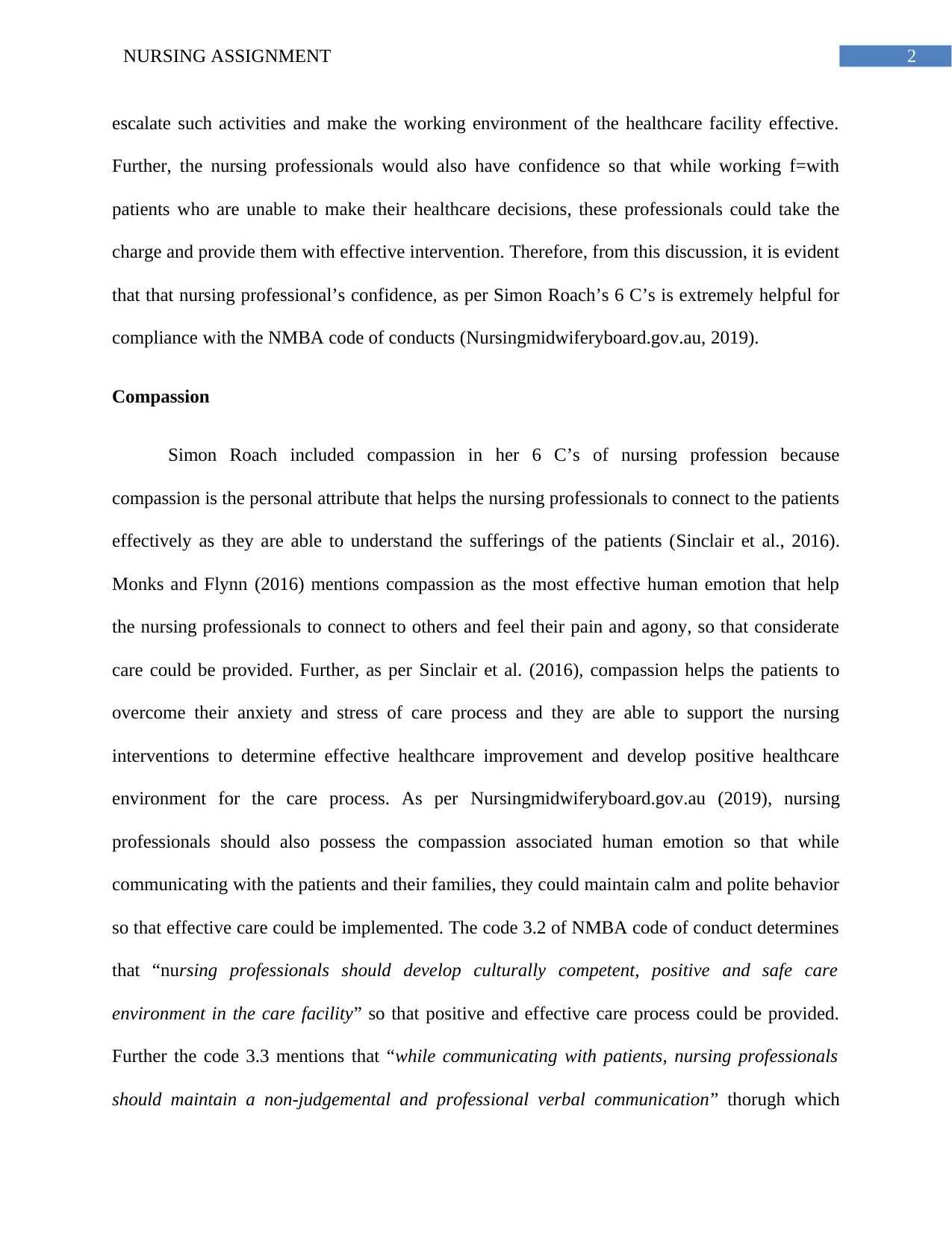
2NURSING ASSIGNMENT
escalate such activities and make the working environment of the healthcare facility effective.
Further, the nursing professionals would also have confidence so that while working f=with
patients who are unable to make their healthcare decisions, these professionals could take the
charge and provide them with effective intervention. Therefore, from this discussion, it is evident
that that nursing professional’s confidence, as per Simon Roach’s 6 C’s is extremely helpful for
compliance with the NMBA code of conducts (Nursingmidwiferyboard.gov.au, 2019).
Compassion
Simon Roach included compassion in her 6 C’s of nursing profession because
compassion is the personal attribute that helps the nursing professionals to connect to the patients
effectively as they are able to understand the sufferings of the patients (Sinclair et al., 2016).
Monks and Flynn (2016) mentions compassion as the most effective human emotion that help
the nursing professionals to connect to others and feel their pain and agony, so that considerate
care could be provided. Further, as per Sinclair et al. (2016), compassion helps the patients to
overcome their anxiety and stress of care process and they are able to support the nursing
interventions to determine effective healthcare improvement and develop positive healthcare
environment for the care process. As per Nursingmidwiferyboard.gov.au (2019), nursing
professionals should also possess the compassion associated human emotion so that while
communicating with the patients and their families, they could maintain calm and polite behavior
so that effective care could be implemented. The code 3.2 of NMBA code of conduct determines
that “nursing professionals should develop culturally competent, positive and safe care
environment in the care facility” so that positive and effective care process could be provided.
Further the code 3.3 mentions that “while communicating with patients, nursing professionals
should maintain a non-judgemental and professional verbal communication” thorugh which
escalate such activities and make the working environment of the healthcare facility effective.
Further, the nursing professionals would also have confidence so that while working f=with
patients who are unable to make their healthcare decisions, these professionals could take the
charge and provide them with effective intervention. Therefore, from this discussion, it is evident
that that nursing professional’s confidence, as per Simon Roach’s 6 C’s is extremely helpful for
compliance with the NMBA code of conducts (Nursingmidwiferyboard.gov.au, 2019).
Compassion
Simon Roach included compassion in her 6 C’s of nursing profession because
compassion is the personal attribute that helps the nursing professionals to connect to the patients
effectively as they are able to understand the sufferings of the patients (Sinclair et al., 2016).
Monks and Flynn (2016) mentions compassion as the most effective human emotion that help
the nursing professionals to connect to others and feel their pain and agony, so that considerate
care could be provided. Further, as per Sinclair et al. (2016), compassion helps the patients to
overcome their anxiety and stress of care process and they are able to support the nursing
interventions to determine effective healthcare improvement and develop positive healthcare
environment for the care process. As per Nursingmidwiferyboard.gov.au (2019), nursing
professionals should also possess the compassion associated human emotion so that while
communicating with the patients and their families, they could maintain calm and polite behavior
so that effective care could be implemented. The code 3.2 of NMBA code of conduct determines
that “nursing professionals should develop culturally competent, positive and safe care
environment in the care facility” so that positive and effective care process could be provided.
Further the code 3.3 mentions that “while communicating with patients, nursing professionals
should maintain a non-judgemental and professional verbal communication” thorugh which
⊘ This is a preview!⊘
Do you want full access?
Subscribe today to unlock all pages.

Trusted by 1+ million students worldwide
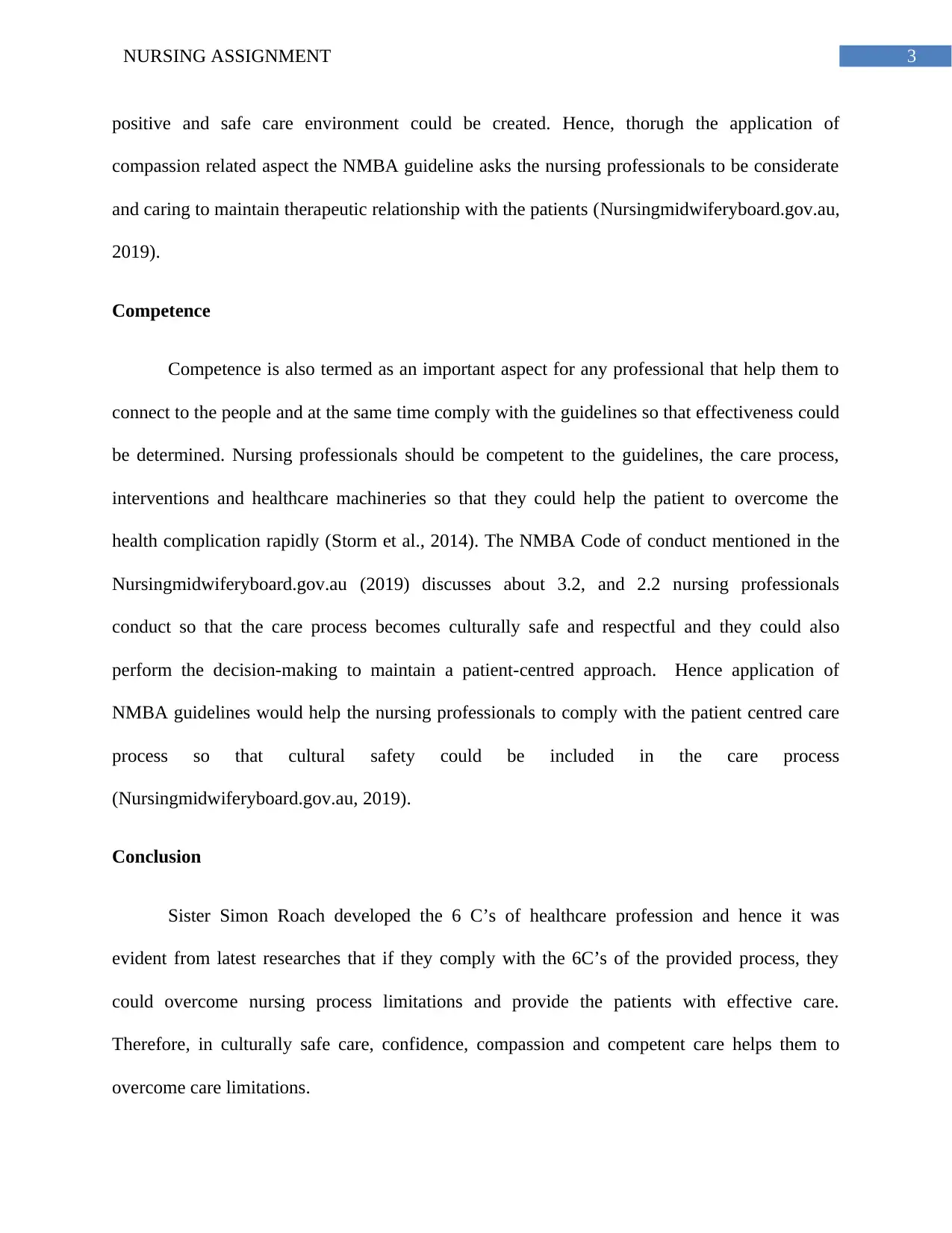
3NURSING ASSIGNMENT
positive and safe care environment could be created. Hence, thorugh the application of
compassion related aspect the NMBA guideline asks the nursing professionals to be considerate
and caring to maintain therapeutic relationship with the patients (Nursingmidwiferyboard.gov.au,
2019).
Competence
Competence is also termed as an important aspect for any professional that help them to
connect to the people and at the same time comply with the guidelines so that effectiveness could
be determined. Nursing professionals should be competent to the guidelines, the care process,
interventions and healthcare machineries so that they could help the patient to overcome the
health complication rapidly (Storm et al., 2014). The NMBA Code of conduct mentioned in the
Nursingmidwiferyboard.gov.au (2019) discusses about 3.2, and 2.2 nursing professionals
conduct so that the care process becomes culturally safe and respectful and they could also
perform the decision-making to maintain a patient-centred approach. Hence application of
NMBA guidelines would help the nursing professionals to comply with the patient centred care
process so that cultural safety could be included in the care process
(Nursingmidwiferyboard.gov.au, 2019).
Conclusion
Sister Simon Roach developed the 6 C’s of healthcare profession and hence it was
evident from latest researches that if they comply with the 6C’s of the provided process, they
could overcome nursing process limitations and provide the patients with effective care.
Therefore, in culturally safe care, confidence, compassion and competent care helps them to
overcome care limitations.
positive and safe care environment could be created. Hence, thorugh the application of
compassion related aspect the NMBA guideline asks the nursing professionals to be considerate
and caring to maintain therapeutic relationship with the patients (Nursingmidwiferyboard.gov.au,
2019).
Competence
Competence is also termed as an important aspect for any professional that help them to
connect to the people and at the same time comply with the guidelines so that effectiveness could
be determined. Nursing professionals should be competent to the guidelines, the care process,
interventions and healthcare machineries so that they could help the patient to overcome the
health complication rapidly (Storm et al., 2014). The NMBA Code of conduct mentioned in the
Nursingmidwiferyboard.gov.au (2019) discusses about 3.2, and 2.2 nursing professionals
conduct so that the care process becomes culturally safe and respectful and they could also
perform the decision-making to maintain a patient-centred approach. Hence application of
NMBA guidelines would help the nursing professionals to comply with the patient centred care
process so that cultural safety could be included in the care process
(Nursingmidwiferyboard.gov.au, 2019).
Conclusion
Sister Simon Roach developed the 6 C’s of healthcare profession and hence it was
evident from latest researches that if they comply with the 6C’s of the provided process, they
could overcome nursing process limitations and provide the patients with effective care.
Therefore, in culturally safe care, confidence, compassion and competent care helps them to
overcome care limitations.
Paraphrase This Document
Need a fresh take? Get an instant paraphrase of this document with our AI Paraphraser
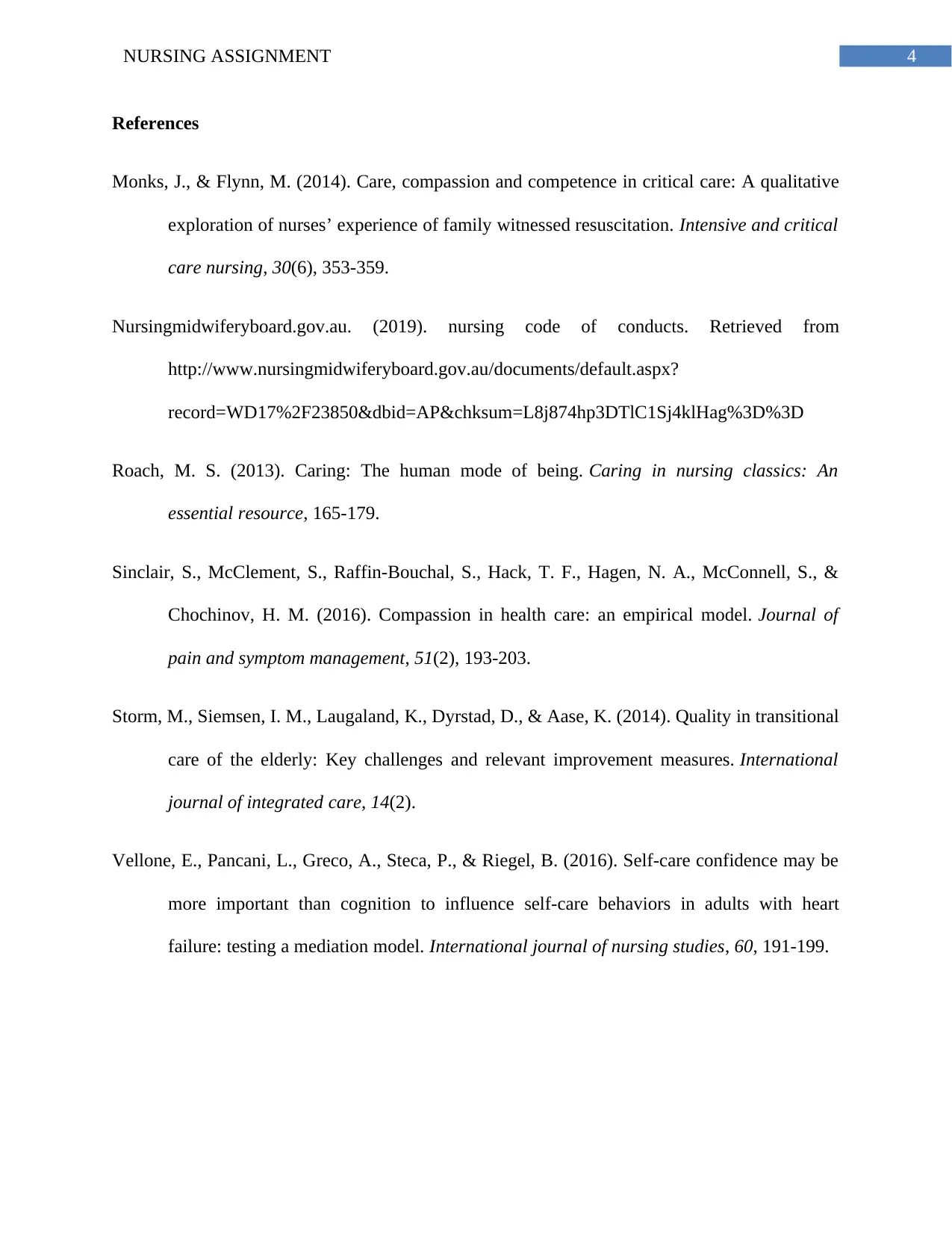
4NURSING ASSIGNMENT
References
Monks, J., & Flynn, M. (2014). Care, compassion and competence in critical care: A qualitative
exploration of nurses’ experience of family witnessed resuscitation. Intensive and critical
care nursing, 30(6), 353-359.
Nursingmidwiferyboard.gov.au. (2019). nursing code of conducts. Retrieved from
http://www.nursingmidwiferyboard.gov.au/documents/default.aspx?
record=WD17%2F23850&dbid=AP&chksum=L8j874hp3DTlC1Sj4klHag%3D%3D
Roach, M. S. (2013). Caring: The human mode of being. Caring in nursing classics: An
essential resource, 165-179.
Sinclair, S., McClement, S., Raffin-Bouchal, S., Hack, T. F., Hagen, N. A., McConnell, S., &
Chochinov, H. M. (2016). Compassion in health care: an empirical model. Journal of
pain and symptom management, 51(2), 193-203.
Storm, M., Siemsen, I. M., Laugaland, K., Dyrstad, D., & Aase, K. (2014). Quality in transitional
care of the elderly: Key challenges and relevant improvement measures. International
journal of integrated care, 14(2).
Vellone, E., Pancani, L., Greco, A., Steca, P., & Riegel, B. (2016). Self-care confidence may be
more important than cognition to influence self-care behaviors in adults with heart
failure: testing a mediation model. International journal of nursing studies, 60, 191-199.
References
Monks, J., & Flynn, M. (2014). Care, compassion and competence in critical care: A qualitative
exploration of nurses’ experience of family witnessed resuscitation. Intensive and critical
care nursing, 30(6), 353-359.
Nursingmidwiferyboard.gov.au. (2019). nursing code of conducts. Retrieved from
http://www.nursingmidwiferyboard.gov.au/documents/default.aspx?
record=WD17%2F23850&dbid=AP&chksum=L8j874hp3DTlC1Sj4klHag%3D%3D
Roach, M. S. (2013). Caring: The human mode of being. Caring in nursing classics: An
essential resource, 165-179.
Sinclair, S., McClement, S., Raffin-Bouchal, S., Hack, T. F., Hagen, N. A., McConnell, S., &
Chochinov, H. M. (2016). Compassion in health care: an empirical model. Journal of
pain and symptom management, 51(2), 193-203.
Storm, M., Siemsen, I. M., Laugaland, K., Dyrstad, D., & Aase, K. (2014). Quality in transitional
care of the elderly: Key challenges and relevant improvement measures. International
journal of integrated care, 14(2).
Vellone, E., Pancani, L., Greco, A., Steca, P., & Riegel, B. (2016). Self-care confidence may be
more important than cognition to influence self-care behaviors in adults with heart
failure: testing a mediation model. International journal of nursing studies, 60, 191-199.
1 out of 5
Related Documents
Your All-in-One AI-Powered Toolkit for Academic Success.
+13062052269
info@desklib.com
Available 24*7 on WhatsApp / Email
![[object Object]](/_next/static/media/star-bottom.7253800d.svg)
Unlock your academic potential
Copyright © 2020–2025 A2Z Services. All Rights Reserved. Developed and managed by ZUCOL.





